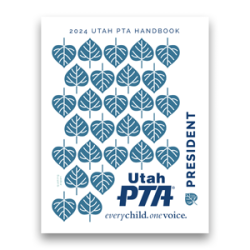Your PTA members look to you for leadership in creating partnerships within your community and fostering an environment where family engagement is encouraged and respected.
Responsibilities include:
- Chairing regular board and general meetings to discuss the plans and business of your PTA
- Taking an active role in financial and legal obligations, including knowing how to stay in good standing with Utah PTA
- Being familiar with the bylaws
- Knowing the responsibilities of the members of the board
- Serving as a liaison with school administration or community partners
- Checking in regularly with officers and committees to ensure the overall plan is on target
- Identifying challenges and inviting solutions
- Familiarizing yourself with all PTA programs and resources
- Representing PTA to the community
- Being in communication with council, region, and state PTA to get any important notices and other information
- Maintaining ongoing communication with members
- Recruiting and mentoring volunteers and future leaders
- Volunteering at events, when available
The president is accountable for:
- Bylaws—Are they current or is it time to renew? (Renew every three years according to the date on the red seal.) A copy of your bylaws is available on your unit page under "My Account." Information on renewing your bylaws can be found at www.utahpta.org/bylaws.
- Parliamentary Procedure—This is a helpful tool to keep order when conducting meetings. Learn more
- ALL PTA Funds—Are to be collected and deposited separately from personal and schools funds. No co-mingling of funds! Always have three people count the money and use the money counting sheet (found in the Treasurer Handbook). Don’t leave money at school or take it home. Get a deposit bag from the bank and make night bank deposits when necessary.
- Records/Minutes
- Any motions made at any of your meetings need to be recorded.
- Copy of approved budget (including minutes of the meeting where the budget was approved) should be sent to your council president/region director.
- Be aware of retention dates (how long to keep financial records).
- Commission Programs and Activities—Encourage commissioners to have committees serve under them to recruit more parents to be involved. This will prevent burnout of board members.
- Membership
- Membership dues aren’t a fund raiser. Send in by the 25th of each month to Utah PTA.
- Inform parents and help them understand what they receive for the Utah PTA and National PTA portions of membership dues. Learn more
- Continue membership drives throughout the year at Back-to-School Night, parent/teacher conferences, and all PTA events.
- Have a membership database. Retain membership by keeping people informed.
- Apply for Membership Awards
- Awards—Recognition is an important factor in retaining quality volunteers. Be aware of deadlines and requirements at www.utahpta.org/utah-pta-awards
- Nominating Committee—Must be elected by December 31. President does not serve on the nominating committee but does give information and direction prior to the first nominating committee meeting. Learn more
- Procedure Book—Contains local board information and duties of commissioners. Learn more
- All Reports—Must be submitted online (three times a year). Learn more

The Utah PTA Handbook is the president's best tool. Every president receives a handbook at convention or afterwards through their region director or council president. You don't need to read the handbook cover-to-cover but it is important to know what is in it. It starts with some general information, followed by the President’s Tools.
The President’s Tools include a president’s checklist, time-line, how to do calendaring, organize your board, make agendas, how to use your bylaws, finances, needs assessments, and much, much more. You should read the whole President's Tools section.
2024 President Handbook - online web format

Watch president training on PTA University. You'll need to login to see it.
